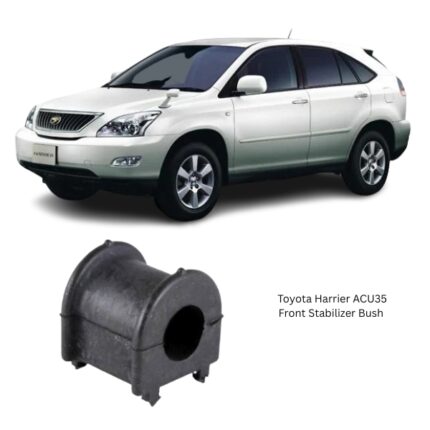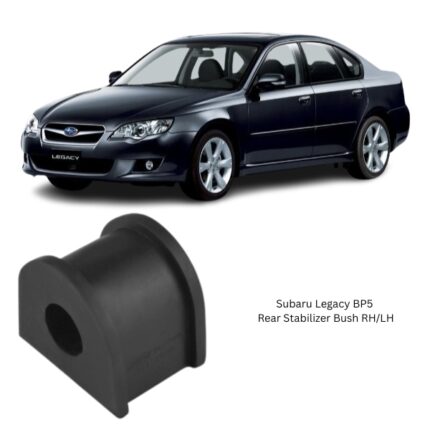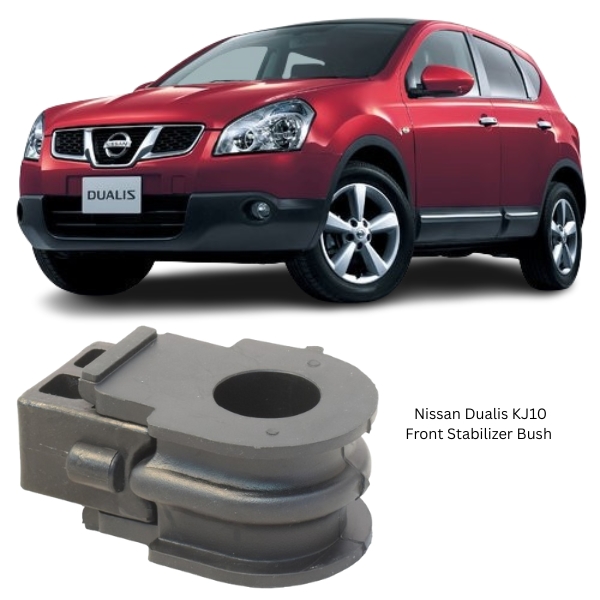Get Nissan Dualis KJ10 Front Stabilizer Bush 54613-JG03A in Kenya
The front stabilizer bush, also known as a sway bar bush, is a vital component in a vehicle’s suspension system. Though small in size, it plays an essential role in stabilizing the vehicle’s body during cornering, braking, and uneven road conditions. It serves as the cushioning interface between the front stabilizer bar (anti-roll bar) and the chassis or subframe, allowing controlled movement while minimizing unwanted body roll and vibrations.
1. Purpose and Function of the Front Stabilizer Bush
The front stabilizer bush supports the stabilizer bar and allows it to pivot while isolating vibrations and noise. The stabilizer bar itself connects the left and right sides of the suspension and works to reduce body roll by distributing weight more evenly when the vehicle turns or hits bumps.
The front stabilizer bush ensures the stabilizer bar functions correctly by:
-
Holding it securely in place.
-
Allowing necessary flexing and twisting of the bar.
-
Absorbing vibrations and road impacts.
-
Reducing metal-to-metal contact and noise.
Without these bushes, the stabilizer bar would wear prematurely, produce noise, or fail to control vehicle roll effectively.
2. Location and Design
The front stabilizer bush is typically located underneath the vehicle, attached to the front suspension subframe or chassis, clamping around the stabilizer bar. Most vehicles have two front stabilizer bushes—one on each side—mounted near the midpoint of the stabilizer bar.
In design, the bush is often:
-
Cylindrical or semi-cylindrical in shape.
-
Made with a slit to allow the bar to slide into the bush.
-
Paired with metal brackets (called clamps or holders) that bolt to the frame, securing the bush in place.
3. Materials and Construction
The front stabilizer bush is made from durable yet flexible materials to balance strength and cushioning. Common materials include:
a) Natural Rubber
-
Offers excellent vibration damping and flexibility.
-
Cost-effective and widely used in standard passenger vehicles.
b) Polyurethane
-
More rigid than rubber.
-
Offers improved performance, especially in performance and off-road applications.
-
More resistant to oil, chemicals, and environmental wear.
c) Synthetic Elastomers
-
Blend of properties tailored for higher resistance to heat, UV light, or ozone exposure.
-
Used in modern vehicles for long-lasting performance.
A high-quality stabilizer bush also incorporates grooves or lubrication channels on the inner surface to reduce friction and allow smooth movement of the bar.
4. How It Works with the Suspension System
When a vehicle turns, the suspension on one side compresses while the other side extends. This movement causes the stabilizer bar to twist. The stabilizer bushes allow the bar to pivot inside them without significant resistance, thus enabling the bar to push back against the motion and reduce the body roll.
For example:
-
During a left turn, the vehicle’s weight shifts to the right. The stabilizer bar transfers some of this force from the compressed right suspension to the left, equalizing the load.
-
The bush allows this twisting action to occur smoothly without metal-on-metal contact and without transmitting excessive noise or harshness into the cabin.
5. Symptoms of a Worn or Failing Stabilizer Bush
Like many suspension components, stabilizer bushes wear out over time due to age, road conditions, or environmental exposure. Common signs of a failing front stabilizer bush include:
a) Clunking or Knocking Noises
-
Especially over bumps or during turns.
-
Caused by excessive movement of the stabilizer bar due to loosened or deteriorated bushings.
b) Poor Handling or Increased Body Roll
-
Vehicle may feel unstable during cornering.
-
Reduced resistance from the stabilizer system due to bush wear.
c) Squeaking Sounds
-
Dry or cracked rubber may squeak during movement.
-
Can worsen in cold or wet conditions.
d) Visible Wear or Cracks
-
Cracked, hardened, or deformed rubber upon visual inspection.
-
Gaps between the bush and the stabilizer bar or chassis.
Ignoring these symptoms can lead to premature wear of other suspension components, reduced handling, and even safety issues during emergency maneuvers.
6. Inspection and Diagnosis
Diagnosing a faulty front stabilizer bush typically involves:
-
Visual Inspection: Checking for visible signs of wear, cracking, or excessive play.
-
Prying the Bar: Using a pry bar to check for movement between the bar and the bushing.
-
Test Driving: Listening for knocks or clunks during low-speed turns or when driving over speed bumps.
If the bush has noticeable gaps or if the bar moves independently inside the bush, replacement is likely necessary.
7. Replacement Process
Replacing the front stabilizer bush is usually straightforward, but access may vary depending on vehicle design. A typical procedure includes:
-
Lifting the Vehicle: Ensure the vehicle is safely raised and supported.
-
Locating the Bushes: Usually found near the center of the stabilizer bar.
-
Removing the Clamp Bolts: Detach the bracket holding the bush in place.
-
Removing the Old Bush: Slide or peel the old bush off the bar.
-
Installing the New Bush: Ensure correct orientation and fitment; some may need lubrication.
-
Securing the Clamp: Reattach the bracket and torque to specification.
It’s advisable to replace both bushes (left and right) simultaneously for consistent performance. In some cases, replacement is recommended alongside stabilizer links for optimal stability.
8. Maintenance Tips and Lifespan
-
Regular Inspection: Check bushes during routine oil changes or suspension inspections.
-
Avoid Harsh Chemicals: Degreasers and solvents can degrade rubber over time.
-
Keep Suspension Aligned: Misalignment can stress the stabilizer system and cause premature wear.
-
Upgrade When Needed: Consider polyurethane bushes for better performance in sporty or heavy-use vehicles.
The average lifespan of a rubber stabilizer bush is 50,000 to 100,000 kilometers, but this depends heavily on road conditions, driving style, and environmental exposure.
9. Role in Vehicle Safety and Comfort
Even though the stabilizer bush is a small part, it has a major impact on:
-
Driving Stability: Minimizing excessive body roll in corners.
-
Ride Comfort: Absorbing road shocks and vibrations before they enter the cabin.
-
Component Longevity: Protecting the stabilizer bar, mounts, and surrounding suspension parts from premature wear.
-
Noise Reduction: Isolating metal parts and reducing rattle or knocking sounds.
Follow us on Facebook for more parts.





Reviews
Clear filtersThere are no reviews yet.